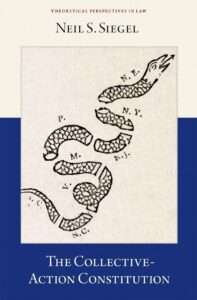The Volokh Conspiracy
Mostly law professors | Sometimes contrarian | Often libertarian | Always independent
Constitutional Interpretation in The Collective-Action Constitution
Third in a seris of guest-blogging posts.

After an Introduction that provides an overview of the book, The Collective-Action Constitution unfolds in three parts over eleven numbered chapters, followed by a brief Conclusion. Part I discusses interpretive and analytical tools from constitutional law and social science that Parts II and III use. Most importantly, Part I identifies the kinds of constitutional arguments that appear in the book and how they relate to originalist and nonoriginalist theories of constitutional interpretation.
For example, originalist argumentation and evidence frequently appear in The Collective-Action Constitution, but not because the book offers an exclusively or conventionally originalist account. Rather, original intentions, meanings, and purposes, like structural inferences, customary political-branch practice, and judicial precedent that developed and endured long after ratification of constitutional provisions, inform how we should understand the Constitution's purposes and thus how we should decide interpretive questions when its language is not fully determinate or does not fully cover the case. Chief Justice John Marshall used this approach in McCulloch v. Maryland (1819), the most important structural decision in U.S. constitutional law. Marshall's pluralist methodology, which he deployed to discern the Constitution's primary structural purpose identified in The Collective-Action Constitution, is challenged now by the rising influence of relatively strict versions of originalism. As constitutional historian H. Jefferson Powell has written, however, Marshall's approach has always been "the constitutional mainstream" in the United States. Marshall's methodology provides the interpretive foundation upon which the book rests.
McCulloch provides critical guidance in additional ways. Marshall develops a theory of the superior democratic legitimacy of the federal government over individual states that justifies federal authority to settle disagreements among states over whether there are cost-benefit collective-action problems in need of solving. He also offers a broad interpretation of the Necessary and Proper Clause that advances the Constitution's collective-action objectives in three respects. The clause indicates the existence of implied legislative powers, which (1) empower Congress to solve some multistate collective-action problems when other powers are unavailable; (2) permit laws that do not themselves help solve such problems (such as the law creating the National Bank) but enhance the efficacy of laws that do; and (3) let Congress build out the executive and judicial branches, which the Articles of Confederation lacked and the Constitution requires if federal laws—including solutions to collective-action problems—will be enforced against states and individuals. Finally, Marshall identifies an enduring democratic-process failure that justifies constitutional limits on state authority to impede federal solutions to collective-action problems or cause such problems, including by taxing federal instrumentalities.
As an interpretive matter, there is a fundamental contrast between what The Collective-Action Constitution is doing and what is usually meant by "originalism" (using the term as someone would who is thinking in good faith, not as window dressing). The sincere, strict originalist is correct in viewing the constitutional text as central to the activity of constitutional law and in regarding respect for the text as critical to the legitimacy of constitutional-law arguments. The text did not fall from the sky; rather, it came into being and was accepted by the American political community as specific times and to address specific problems and concerns. Interpretive approaches that completely sever the connection between constitutional argumentation and those historical specificities risk delegitimizing themselves because they may boil down to using Constitution-talk to mean whatever the speaker prefers as a matter of political morality.
Even so, the strict originalist, in my view, mistakenly reduces all of constitutional law to the interpretation of the original meaning of the words of the discrete provisions of the constitutional text. Such a "clause-bound interpretivism," as John Harty Ely described the position, misses the point of the words. The point, above all in the 1787 text, was a serious, thought-through, and debated attempt to solve the governance problems that existed in the 1780s and that were mostly incapable of being solved either by the weak national government created under the Articles of Confederation or by the state governments acting individually or collectively outside the Confederation Congress. More precisely, the point was to solve the central problem—the singular really is right—that the Union faced in the 1780s: the Union-destroying ways in which the states were relating to the central government and to one another. To adequately appreciate and realize the point of the words of the 1787 text, purposive, structural, practice-based, and consequentialist arguments are needed in addition to textualist and originalist ones.
The Collective-Action Constitution continuously returns to the various provisions of the Articles of Confederation to recover the point of the text of the 1787 Constitution and to suggest how the problems facing American society today can be addressed in a way that faithfully adheres to the solutions embodied in the text. For example, the original Framers and ratifiers did not know about climate change, but they knew all about other free-rider problems. Chapter 9 of the book outlines a parallel approach to the Reconstruction Constitution, which was thoroughly considered and adopted to address a different problem facing the Union in the 1860s: the dignity-destroying ways in which states were relating to their own inhabitants. The Reconstruction Congress did not know about sexual-orientation discrimination, but they knew all about other caste systems.
To a very great extent, the very lawfulness of constitutional law and the legitimacy of judicial decisions rest upon fidelity to the written Constitution. Strict, good-faith originalists are right about that. The Collective-Action Constitution models how a methodological pluralism committed to original constitutional purpose can maintain such fidelity while enabling American society to effectively address current concerns. "This provision," after all, "is made in a constitution, intended to endure for ages to come, and consequently, to be adapted to the various crises of human affairs." McCulloch, 17 U.S. 316, 415 (1819).


Show Comments (8)